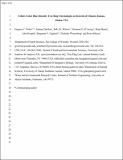Yellow-cedar blue intensity tree ring chronologies as records of climate, Juneau, Alaska, USA
Abstract
This is the first study to generate and analyze the climate signal in Blue Intensity (BI) tree-ring chronologies from Alaskan yellow-cedar (Callitropsis nootkatensis D. Don; Oerst. ex D.P. Little). The latewood BI chronology shows a much stronger temperature sensitivity than ring-widths (RW), and thus can provide information on past climate. The well-replicated BI chronology exhibits a positive January-August average maximum temperature signal for 1900-1975, after which it loses temperature sensitivity following the 1976/77 shift in northeast Pacific climate. The positive temperature response appears to recover and remains strong for the most recent decades although the coming years will continue to test this observation. This temporary loss of temperature sensitivity from about 1976 to 1999 is not evident in RW or in a change in forest health, but is consistent with prior work linking cedar decline to warming. A confounding factor is the uncertain influence of a shift in color variation from the heartwood/sapwood boundary. Future expansion of the yellow-cedar BI network and further investigation of the influence of the heartwood/sapwood transitions in the BI signal will lead to a better understanding of the utility of this species as a climate proxy.
Citation
Wiles , G C , Charlton , J , Wilson , R , D'Arrigo , R D , Buma , B , Krapek , J , Gaglioti , B V , Wiesenberg , N & Oelkers , R 2019 , ' Yellow-cedar blue intensity tree ring chronologies as records of climate, Juneau, Alaska, USA ' , Canadian Journal of Forest Research , vol. In press . https://doi.org/10.1139/cjfr-2018-0525
Publication
Canadian Journal of Forest Research
Status
Peer reviewed
ISSN
0045-5067Type
Journal article
Description
This work was supported by the National Science Foundation’s Paleoclimatic Perspectives on Climatic Change (P2C2) Program grant nos. AGS 1159430, AGS 1502186, AGS 1502150, and PLR 15-04134 and by the Keck Geology Consortium funded by The National Science Foundation under Grant No. (NSF-REU #1358987).Collections
Items in the St Andrews Research Repository are protected by copyright, with all rights reserved, unless otherwise indicated.

